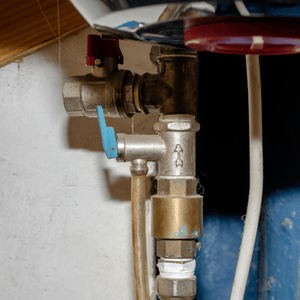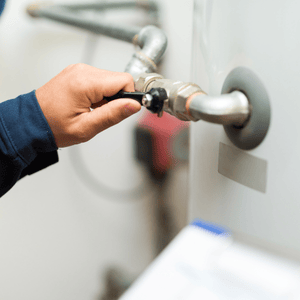When it comes to keeping your water heater—and your home—safe, the T&P valve is the unsung hero. Short for temperature and pressure valve, this small but mighty part plays a big role in preventing dangerous pressure buildup in your water heater. If it’s working properly, you won’t give it a second thought. But when if you’ve got a T&P valve failing on you? That’s a problem you can’t afford to ignore.
At AC Pros, we know water heaters might not be the most glamorous topic, but trust us: understanding your T&P valve can save you from expensive repairs, water damage, or worse. Let’s dive into what this little valve does, how to spot trouble, and what you can do about it.
What Is a T&P Valve? Your Water Heater’s Safety Net

A T&P valve, or Temperature and Pressure Relief valve, has a simple but critical job: to release excess pressure or temperature from your water heater. Its primary function is to prevent the water heater from building up excessive temperature or pressure, which could lead to dangerous explosions or damage.
What Does a T&P Valve Do?
- Releases Pressure: If the pressure inside the water heater exceeds the valve’s limit (usually 150 psi), the T&P valve opens to release water and relieve the pressure.
- Releases Excess Heat: If the water temperature exceeds a safe threshold (typically 210°F), the valve will release hot water to prevent overheating.
How to Identify a T&P Valve:
A pipe runs from the valve down to the floor or another designated drainage area. This pipe ensures water released during operation is safely redirected.
Location:
Typically found on the side or top of the water heater.
Connected to a discharge pipe that directs released water to a safe location (like a drain or floor).
Appearance:
A small brass or metal valve.
Has a lever or handle for manual testing.
May have a threaded or pipe connection to the water heater tank.
Markings:
Often labeled with temperature and pressure ratings (e.g., 150 psi, 210°F).
Connected Discharge Pipe:
A pipe runs from the valve down to the floor or another designated drainage area. This pipe ensures water released during operation is safely redirected.
Learn a DIY energy savings project from the US Dept of Energy & lower your water heating temperature.
How to Tell if a T&P Valve Is Bad: Red Flags You Can’t Ignore
Your T&P valve might not have a flashy alarm system, but it does leave clues when it’s not working right. Here’s what to look out for:
- Constant Dripping or Leaking
If your T&P valve is leaking, it’s often a sign that something isn’t right. It could be excessive pressure in your system or a worn-out valve. Either way, ignoring it won’t make it go away. You can read more here about what to do when your water heater is leaking.
- Rust or Corrosion
Spotting rust around your valve? That’s a sign it might be on its last legs. Rust can stop the valve from opening and doing its job—something you definitely don’t want.
- Unusual Noises
Whistling or hissing sounds near your water heater could mean the T&P valve is struggling to release pressure. Not sure if it’s the valve or something else? That’s where we come in.
- No Response to Testing
Here’s a quick test: lift the valve’s lever (gently!) to see if water comes out. If it doesn’t, or if it gets stuck, your valve might need a replacement. Just be careful—this can get messy!
Ignoring these signs is like ignoring that check engine light on your car. Sure, it might seem fine for now, but eventually, it’s going to catch up with you.
Should the T&P Valve Be Open or Closed?

Let’s clear this up: in normal conditions, your T&P valve should stay closed.
It only opens when it needs to release pressure or temperature. If it’s open all the time, that’s a big red flag. You’re either dealing with too much pressure in the system or a faulty valve.
Here’s a common question we hear: “Can I just leave it open if it’s dripping?” Short answer: no way. That’s like leaving your fridge door open to cool your kitchen—it’s not fixing the problem, and it’s only making things worse.
How to Stop a T&P Valve from Leaking: Quick Fixes and Long-Term Solutions
A leaking T&P valve isn’t just annoying—it’s a warning sign. Here’s how to tackle it:
- Check the Pressure
Sometimes, your water heater’s pressure might be too high. Installing a pressure-reducing valve can help keep things under control.
- Inspect for Debris
Mineral buildup can clog the valve and cause leaks. Flushing the valve might solve the problem, but be careful—this can get messy fast.
- Replace the Valve
If your valve is old, corroded, or damaged, it’s time for a replacement. Don’t put it off—it’s better to handle it now than deal with water damage later.
- Call a Pro
If you’re not sure what’s causing the leak, we’re here to help. Sometimes, it’s not just the valve—it could be an issue with your entire water heater system.
Pro Tip: Regular maintenance can catch these issues before they turn into major problems. When’s the last time you gave your water heater a little TLC?
Why T&P Valve Maintenance Is the Key to a Healthy Water Heater
Taking care of your T&P valve is like changing the oil in your car—it’s a small step that makes a big difference. Regular inspections can help you avoid costly repairs and extend the life of your water heater.
At AC Pros, we recommend checking your valve at least once a year. Not sure how? That’s where we come in. During our tune-ups, we’ll make sure your T&P valve is in tip-top shape and take care of any other maintenance your water heater might need.
And hey, if you’re in the Austin area, you know how unpredictable Texas weather can be. One day it’s a cozy 70 degrees, the next it’s a winter freeze. (Check the latest weather updates here.) Keeping your water heater in good condition means fewer surprises when you need hot water the most.
FAQs: Answering Your T&P Valve Questions
What is a T&P valve?
It’s the temperature and pressure valve on your water heater that releases pressure to keep things safe.
How to tell if a T&P valve is bad?
Look for leaks, rust, unusual noises, or a valve that won’t respond to testing.
How to stop a T&P valve from leaking?
Start by checking the pressure and cleaning the valve. If that doesn’t work, it might need replacing.
Should the T&P valve be open or closed?
It should stay closed during normal operation, opening only to release excess pressure or temperature.
When to Call the Experts: Why AC Pros Is Your Go-To for T&P Valve Issues
Dealing with T&P valve problems can feel overwhelming, but you’re not alone. At AC Pros, we’ve seen it all—and we’re here to help. Our NATE-certified technicians know water heaters inside and out, and we’ll get your system back in shape in no time.
Plus, we’re all about transparency. No hidden fees, no gimmicks—just honest, reliable service. Need a new T&P valve? We’ve got you covered. Want to schedule a tune-up? Let’s do it. Think you might have a bigger issue on your hands? We’ll figure it out together.
Read more: When to Replace Your Water Heater: 11 Telltale Signs You Shouldn’t Ignore
Don’t Ignore the Signs—Protect Your Home Today
Your water heater’s T&P valve might not be the star of the show, but it’s one of the most important parts of your system. Catching problems early can save you from headaches, repairs, and even disasters down the line.
If you’re in Austin or the surrounding areas and think your T&P valve might be failing, give AC Pros a call. We’re here to make sure your water heater stays safe, reliable, and ready to handle whatever Texas throws your way. Let’s keep your home comfortable—no leaks, no stress, no problem.
